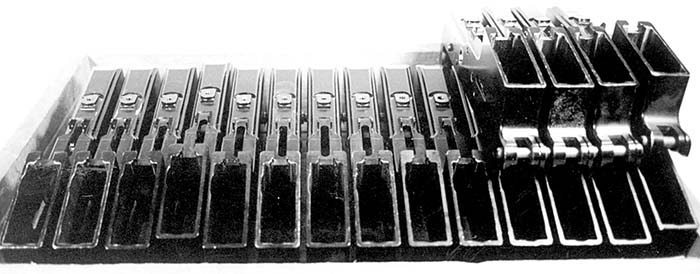By William R. Bishop
In the first part of this two-part series on Fabrique Nationale’s FNC carbine we learned about its background, technical details and operating characteristics. Now, in this concluding episode we will go into the details of actually converting an FNC into a thoroughly reliable select fire weapon. This is done using a registered transferable sear. Yes – it can be done – and to factory standard, too!
When you consider a weapon for conversion to full automatic (fully transferable, of course) there are four critical areas to research:
* Design of the base weapon itself. Does it lend itself to conversion with few additional changes?
* Are appropriate feed devices such as high capacity magazines available in sufficient quantity?
* Is it in an available ammunition caliber? Preferably, it should be procurable in milspec surplus lots which are made on modern equipment with quality components.
* Finally, and foremost, is the BATF-registered part (sear or bolt) actually available and at a price that will not make you take a second mortgage on the house?
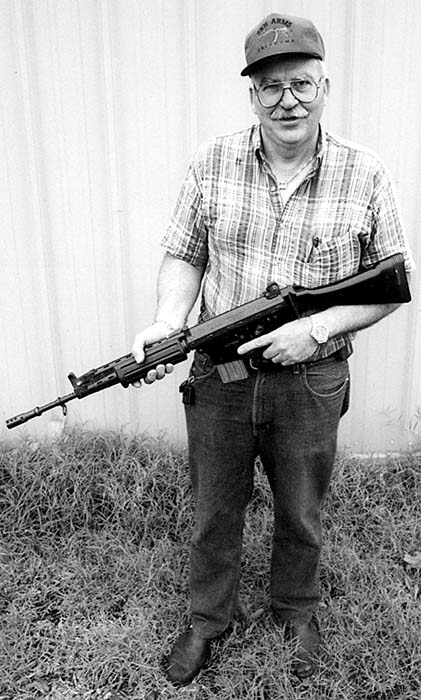
The FNC is an excellent candidate for transformation into a true assault rifle. It is well built with a solid design. When FN manufactured approximately 6000 semiautomatic rifles for import into the US during 1982-1988 they made few changes from the standard military version. For conversion purposes, this means intricate machining and/or parts replacement will not be necessary. Unlike conversions such as IMI’s Uzi which had numerous deviations from the full auto design (barrel trunnion, receiver bolt block, sear holes, safety block, etc.) the imported FNC remains very close to the original. This was taken to such a degree that semiauto FNC’s retained the built-in rifle grenade sight which, when activated, cuts off the porting through the gas block. Even the owner’s manual is the same as provided to military users.
Other critical areas which indicate the FNC is a superb candidate for select fire conversion include the type of high capacity magazine it employs and availability of milspec ammunition. As the mag well is built to NATO STANAG 4179 and uses milspec 20 and 30-round M16 magazines the reserve of highcaps is essentially limitless. Further, the supply of milspec 5.56mm ammo which duplicates the performance of the US M193 55gr. round is quite robust and will be for years into the future. Should you handload, the components such as powder, brass and bullet are all available in bulk lots.
Finally, the last and most important question regarding a fully transferable conversion to full auto: what does BATF consider to be the registered part and are any available? This is not an idle question given that H&K sears sell at $2500, AR15 auto sears around $2300 and Uzi 9mm bolts at $1300. Even with these stratospheric prices there remain very few available on the open market. The demand far outstrips the supply – and it will only get worse.
I knew from my research the FNC passed the first three checkpoints with no problem. Its semiauto design is extremely close to the military version and it fires the 5.56mm M193 cartridge via common AR15 magazines. So far so good. Now, what about the registered part? What was the availability and cost of this critical item?
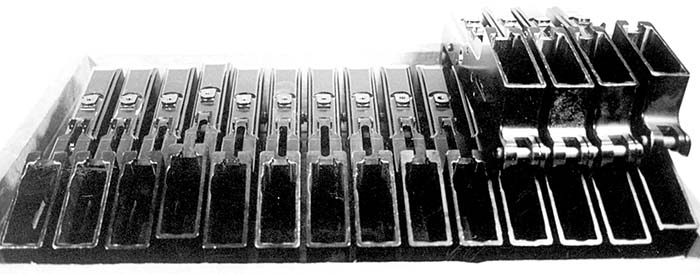
Good news!
BATF considers the registered part to be the trip sear and…and…it is plentiful and available at a very reasonable cost!
Amazingly, the cost of this sear and the entire process to convert the FNC to select fire can be done to the highest standards and for as low as $800. Should you wish to convert your FNC to select fire with a three-round burst option the cost modestly increases to $1000. Now that you have recovered your breath and demand to know more, let’s see how this modern-day miracle is really performed.
Conversion Process
The conversion of the FNC to full auto follows the same basic process as used in AK and FAL conversions. This process includes:
* Lower receiver modifications
* Bolt carrier modification
* Function testing
While there are numerous nationally known C2 manufacturers who can properly convert various weapons to select fire, only one can do it for the FNC. This is Curtis Higgins of S&H Arms of OK. The remainder of this article will focus on Curtis’ work as he has consented to allow Small Arms Review into his shop and see how it is properly done.
Curtis is nationally known in the C2/3 business and has been in operation for many years. He has offered a select fire version of the FNC since 1986 which is classified by BATF as a registered sear gun. What makes Curtis’ conversion so desirable is that he uses an absolute top quality sear and and now has access to brand new factory full auto fire control parts. This conversion is then carried out with very high precision metalworking equipment and finished with a correct selector switch remarking. The end product is as close to a genuine factory FNC as you can get this side of Liege, Belgium.
Let’s now follow Curtis as he converts a semiauto FNC into a true select fire rifle. The end result will be a most interesting weapon with a very appreciative market value – and really fun to shoot!
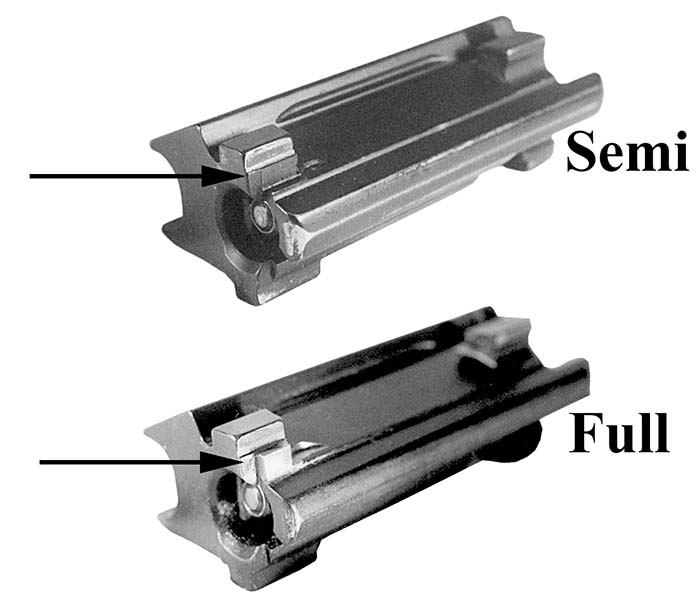
Lower Receiver Modifications
The first thing Curtis does when he receives a customer’s FNC is to thoroughly inspect it for wear and serviceability. Any part not meeting factory specifications is noted and the customer is contacted for resolution. Due to the FNC’s reliability and escalating market value he has never received one in unserviceable condition. Further, Curtis makes very sure all parts are bagged and kept together with the same rifle. What you send him is what you get back – nothing is “swapped” out.
Next, the lower receiver is partially stripped in preparation for installation of the registered sear and selector remarking. The first thing to be pulled is the fire control mechanism. This is done by rotating the selector switch to the 12 o’clock position and extracting it to the left. Levering out the safety support cradle and its axis pin allows removal of the fire control mechanism. The hammer spring and spur are then rotated out with the use of a special tool. This tool captures the head of the spur and allows spring compression and outward rotation. Next, the hammer axis pin, SA hammer, trigger pin, trigger and trigger spring are all removed. Then, the magazine catch pin is drifted out and the catch along with its spring are withdrawn. Finally, the handgrip and buttstock have their retaining screws removed and these items are pulled off.
With the lower receiver mostly stripped – essentially the two receiver pins are all that is left – Curtis now engraves additional selector switch markings to reflect its full auto status. The markings on a semi FNC are “S-1” to show safe and semiauto functioning. The additional markings of “3-A” are then added to identify the three-burst and full auto functions. He does this by first bolting the stripped receiver onto the bed of a carbide-tipped rotary engraving machine. Positioning must be very precise as no mistakes are allowed. Once the receiver is engraved, you cannot go back and re-do it again!
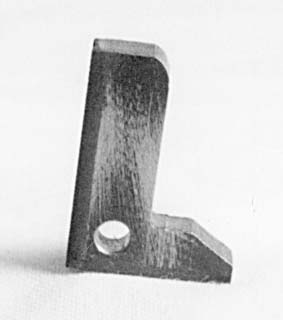
After verifying with a machinist’s rule the final location of the “3-A” symbols, Curtis places the pantograph stylus into the copper scribing template and begins the cuts. After several minutes of constant work, and a final wiping away of the cutting oil, the new “3-A” symbols are revealed. He then fills in these symbols with red enamel to match the existing FN markings. The result is a four-position lower receiver (S-1-3-A) which is factory correct in function and appearance. It is simply beautiful.
With the fire control mechanism removed and the selector switch symbols added, it is time for the sear installation. The process in doing so is proprietary to S&H Arms of OK, but having observed it first hand I can assure you it is absolutely reliable and simple. Total time to install one is approximately twenty minutes and once in place is a very rugged addition to the FNC. The sear itself has a Rockwell hardness in the mid-40’s and is made of 4130 steel which has been precisely machined and hardened via an oil quenching. Its shape, location and the relationship it presents to the hammer and bolt carrier were all developed by Curtis. Further, he has never had a sear fail or wear out.
After the sear installation is completed, Curtis performs final quality checks and then begins the fire control mechanism upgrade. There are two routes he may now take: 1) safe-semi-full auto functioning, or, 2) safe-semi-burst-full auto functioning. The choice is up to the customer. The initial entry route of $800 will get you choice 1, while an additional $200 will gain you choice 2. Guys, spend the additional funds and get choice 2 as it is what makes an FNC truly factory correct!
For choice 1, Curtis notches the existing SA hammer and installs all the original fire control parts back into the FNC. A note of interest: unlike semiauto Colt AR15’s, the semiauto FNC selector switch is exactly what the military uses and already machined to support both full automatic and burst fire. One less replacement part to worry about! The conversion is now complete and when the selector switch is placed in the “burst/3” mode will continue to fire semiautomatic.
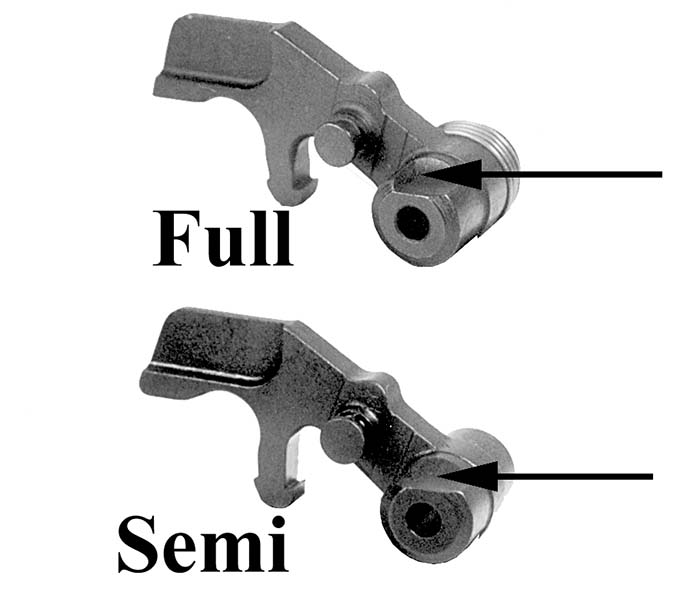
Choice 2 is much more interesting. First, he deletes the semiauto hammer and its safety support cradle and replaces them with a factory three-shot burst ratchet counter and full auto hammer. These rare parts are produced by the FN-licensed factory in Indonesia and are fully equivalent in specification to those from the European FN plant. Once unheard of in the US, these items along with a complete line of brand new FNC parts are now being stocked by Tampa Bay Military and Police Supply. If you own an FNC you need to call them.
With the necessary fire control parts replaced, the lower receiver work is completed by installing the trigger, mag catch mechanism, furniture, etc. Final quality checks are then performed by Curtis and the lower receiver conversion is now complete.
Bolt Carrier Modification
The bottom of the bolt carrier is modified by building up a sear trip shelf with TIG welding material. It is then carefully machined to correct (and proprietary) dimensions with a Bridgeport mill. This is a critical step as the timing of the full automatic process is dependent on the precise moment when the modified bolt carrier trips the registered auto sear. The sear then releases the hammer after the bolt has achieved lockup with the barrel extension. Incorrect timing of the bolt carrier could result in poor functioning, a destroyed receiver – or worse.
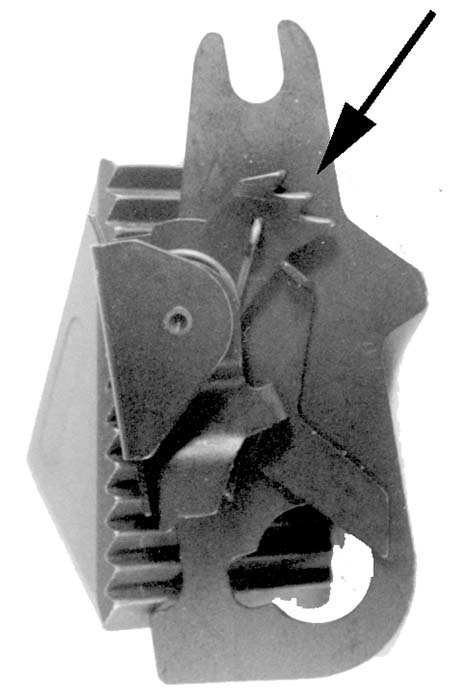
Sequence of Operation
When the selector switch is placed into the full automatic (“A”) position and the trigger is pulled several things start to happen. The hammer, which has been held back by both the automatic safety and secondary sears, is set free. It rotates forward and strikes the firing pin, which then impacts the primer to begin the ignition sequence. When the hot gasses from the burning propellant pass the barrel porting hole some of them are bled off to travel through the gas block. These gasses impinge on the gas piston and drive back the bolt carrier assembly. During this rearward travel a ramp on the bottom of the bolt carrier strikes the hammer to rotate it backwards. Since the FNC is in the “A” position a cut in the selector switch axle has caused the secondary sear to be rotated back and out of position. The hammer is therefore not caught by this secondary sear and is retained by just the automatic safety sear. As the bolt assembly moves forward it strips off a cartridge, which is then pushed up the feed ramp and into the barrel chamber. When the lugs on the bolt begin to lock into their recesses the bolt carrier trip shelf impacts the automatic safety sear. This sear then disengages from the hammer which in turns rotates forward to strike the firing pin…and the sequence begins again. Whew! And to think this occurs approximately 700 times per minute.
When the selector switch is in the “3” position a slightly different sequence occurs. Each time the hammer rotates forward it contacts a spring-loaded pawl which is part of the three-shot burst mechanism. The rear tip of this burst mechanism engages the secondary sear and keeps it off the hammer. When three rounds have been fired and the pawl has clicked its way through the toothed counter, a spring flips up the burst mechanism which then releases the secondary sear. This sear re-engages the hammer and holds it back. Should the trigger be released before three shots are fired the spring-loaded burst mechanism snaps back to reset itself in preparation for the next burst. Typically, a three round burst can be fired in .2 second.
When the selector is in the “1” position the secondary sear is always engaged to hold back the hammer after each shot.
Function Testing
The final part of the conversion is a live fire test. Curtis runs a magazine of either Olin or Federal “white box” paramilitary ammo through the FNC to check semi, burst (if ordered), full auto and safety functions. As the rounds are going downrange he carefully observes the timing, ejection pattern, ignition reliability and intangibles. Once the FNC passes this real world test it is carefully packaged back up and shipped to the customer upon ATF form approval. Curtis is adamant that nothing is shipped until he talks with the actual person receiving the FNC.
FNC users have reported to me the full auto FNC is sometimes partial to certain brands of ammo. While all brands function quite fine in the semi mode, Winchester and Hirtenberger rounds sometimes cause stoppages in burst and full automatic. The suspected problem area is the pressure curve generated by their powder. South African, IMI, PMC and other 5.56mm rounds work fine in any mode. Also, commercial reloaded ammo seems to work very well regardless of selector switch setting.
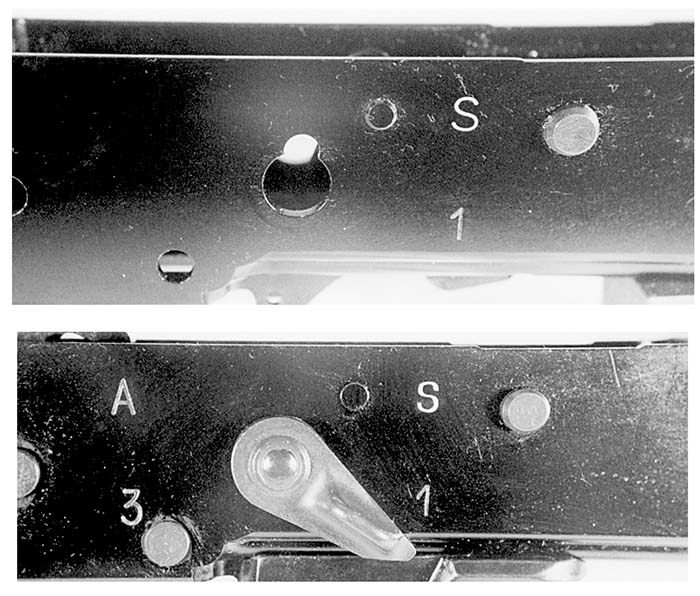
Shooting Impressions
Firing the FNC on full auto is very similar to that of the M16-series rifle. Recoil seems to be a little more robust due to a different buffer system which has less spring length. This may also accentuated by the very solid folding stock which transmits the recoil into the shoulder. Also, the lack of a bolt-hold open on the last shot requires a bit of getting used to as the Europeans do not view this as being necessary on a small arm. Further, given its barrel diameter/length and cooling efficiency the cyclic and maximum rate of fire should be the same as the M16A1 – 700 and 65 rounds per minute respectively. This is typical for a modern, small caliber, select fire assault rifle.
Since the cost of full auto weapons is continuing to go through the roof, the wear endured by the FNC when wringing it out should be considered. This is an area where it shines, and for several very good reasons! The barrel itself is hammer forged and then chrome lined. This results in a hard barrel with a “slippery” bore which is resistant to excess wear. Should you have someone cyrogenically freeze the barrel to eliminate internal stresses and increase its surface hardness the wear will be reduced even further.
The barrel extension (which contains the locking lug cutouts) and twin-lug bolt are cast and then machined. The bearing surfaces in these two areas have a very large amount of contact and thus further reduce the wear as impact/shear forces are spread over a sizable area. My experience with Swedish FNC’s (known as the AK5) in Bosnia indicates that wear of the barrel and bolt assembly are not an issue. Even so, TBMP is importing high quality factory parts to provide backup. Purchase two spare firing pins and perhaps one additional hammer spring to gain peace of mind.
When the FNC is fired the brass does get dented a bit. The case mouth bounces off the right side of the receiver and cocking slot cover before pitching to the side. Typically, a smoking pile of brass will build up 20-30’ to the right front of the muzzle. As the FNC can rapidly eat ammunition I save handloading time and use the excellent quality 55gr. IMI M193 cartridge which is available from Cole Distributing. Recent accuracy testing I conducted on this round (with my FNC) clearly showed it yielded 2-2.5 MOA even after extended fire – with iron sights! Finally, that nice black enamel finish on the barrel does have one weak point. After a short period of firing the area of the barrel just in front of the chamber will exhibit scorched paint. This is simply part of the FNC’s character and can be left as is or else molycoated to restore a heat resistance coating of beauty.
Conclusion
This article has described in detail the process involved in selecting and converting a semi-automatic rifle to select fire. In this case, Fabrique Nationale’s FNC carbine. The FNC meets the four primary criteria of a candidate weapon. It adheres very closely to the factory full auto weapon and requires few new parts to achieve a correct conversion…and the parts are on the market. Further, it uses the very common AR15/M16 20 and 30-round magazines while the availability of suitable milspec 5.56mm ammunition is a major plus.
Finally – and this is the most important point – high quality registered auto sears are fully available and RELATIVELY INEXPENSIVE!!! Most importantly, should you desire to convert the FNC to select fire it can be faithfully done to factory standard.
Enough said.
Check out Fabrique Nationale’s FNC and its conversion to select fire… give Curtis a call…and you will become a convert like me!
S&H Arms of OK
Attn: Curtis Higgins
PO Box 121
Owasso, OK
(918) 272-9894
Tampa Bay Military & Police
Supply, Inc.
Attn: Dana Reed
501 S. Falkenburg Rd.
Tampa, FL 33619
(813) 662-9433
fullauto@gte.net
Cole Distributing
Attn: Gary Cole
PO Box 50271
Bowling Green, KY 42102-2871
(502) 843-6844
| This article first appeared in Small Arms Review V2N4 (January 1999) |



